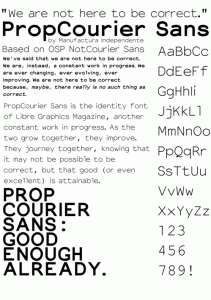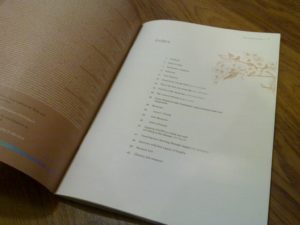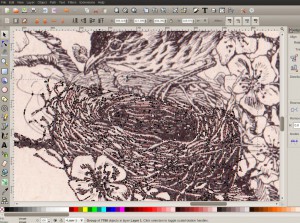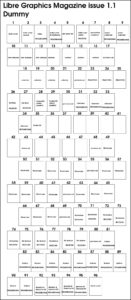An interview with Ana Carvalho, ginger coons and Ricardo Lafuente, editors of Libre Graphics Magazine (ISSN: 1925-1416).
This interview was conducted over IRC on Thursday December 30 2010. You are reading a slightly edited version (the original chat protocol can be found at the bottom of this page). This interview is licensed under CC-BY-SA.
Manuel Schmalstieg — First of all, I would like you three to introduce yourself, and also give an overview of the main contributors to the Libre Graphics Magazine #1.
Ana Carvalho — I have a degree in Communication Design. I currently work as a freelance web and UI interface designer. I became involved with the Libre Graphics Community and the Free Software Movement in general in 2006. Since 2007 I’m working mainly with free software. I’m involved in a small press venture—http://planapress.org—that I present at last LGM. It is dedicated to publishing comics and illustration using free software and open licenses. I live and work in Porto, Portugal.
Ginger Coons — I trained as a graphic and web designer (BFA in Design, Concordia University, Montreal) but, after working for a very commercial web design firm, got fed up pretty quickly with the design for hire approach. I still do freelance work, but what interests me more is design research. I started working with F/LOSS graphics in 2001, but only got involved in the community in 2009, when I gave a talk at Libre Graphics Meeting in Montreal. Now I’m finishing my Masters degree, working on a thesis about colour standards for print. And I do advocacy work, introducing designers and artists to F/LOSS. My own work is at http://adaptstudio.ca. And these days, I’m based in Toronto (Canada).
Ricardo Lafuente — My name is Ricardo Lafuente, and my academic background is communication and media design (BA at Porto Fine Arts, MA at Piet Zwart Institute in Rotterdam). I’ve been doing stuff as a designer, hacker, artist and coder. I made the switch to FLOSS tools in 2006, and since then i’ve been mostly working with code for design purposes, as well as coding for the web and other kinds of hacks. Since September i’m a teacher at Porto University’s Fine Arts College, teaching code to design students. (I have a rather sparse and incomplete portfolio website at http://ricardo.koizo.org). I’m now mainly working together with Ana, at an informal design research studio that we call Manufactura Independente (http://manufacturaindependente.org). We also help run Hacklaviva (http://hacklaviva.net), a Porto hackerspace where we try to make connections between FLOSS culture, social intervention and cultural activity.
I also live and work from Porto.
MS — Thanks. I understand that you three are the core editorial team. What other people were involved, to what degree? And was the work done via online .CA / .PT communication, or rather in one geographic place?
Ginger Coons — For our very first (trial) issue, we were actually in one place at the same time. That’s issue #0, which we completed in May 2010 at the Libre Graphics Meeting in Brussels. Even most of our contributors for that one were actually in the same room as us. But things have been very different since then.
Ricardo Lafuente — (as an aside, it was done in 3 days from start to finish, and is available here).
MS — So #0 was done in the context of a “local” event. Was that different for #1 ?
Ginger Coons — This time around, almost all of our work was done by distance. We met once, for a few hours, in Barcelona, in November. Our contributors are from around the world (although both interviews in the issue took place in person). And most of our collaboration was helped around by a shared git repository.
Ana Carvalho — We have a mailing list we use frequently.
Ricardo Lafuente — And also a community advisory board, made up of 5 people who are connected, in some way or another, to the Libre Graphics scene. The board’s purpose is to advise us when we reach some hard-to-decide editorial decisions.
MS — Was the release date linked to some special context – festival, conference …
Ginger Coons — The release date actually was chosen strategically, although we overshot a little. The plan was to have print copies of the magazine on hand in November so that we could take them to a number of events. At the beginning of November, FOSSASIA took place in Vietnam. The DIY Citizenship conference happened in Toronto and the HTMlles festival happened in Montreal. All in one weekend. We had hoped to send magazines to all these events, as well as to the Expozine small press fair. Unfortunately, we didn’t get all of our printing sorted out in time. But that was part of the strategic reasoning behind November. Plus, it works with our release cycle. We released an issue last May, we knew we wouldn’t be able to get one ready in August, so we decided to go, from November, with a November-February-May-August release cycle.
MS — Regarding the release cycle, I read sometimes 1.1 and sometimes #1 – which is correct?
Ricardo Lafuente — Both are, in a way. Our idea was to use 1.1-1.4 for our first year run.
Ginger Coons — 1.1 is the volume and issue number. #1 is the issue number. What it means is that there’ll be another #1, this time next year, but it’ll be the #1 of volume 2. Hence, 2.1
MS — As I see it, the mag was born in the context of the LGMeetings, but is structurally independent from it.
Ginger Coons — yep.
MS — But it’s through that meetings/conferences that your team came together.
Ginger Coons — For sure. But we realize that we need to grow a presence beyond the confines of an annual meeting.
MS — Now a bit more about content … what were your founding ideas, when you decided to do a “magazine” – what does this term mean actually, today.
Ginger Coons — We see the importance of a print magazine as being largely in its accessibility and immediacy. We really have to trace ourselves to two different start dates. And two different ideas. In May, someone (Femke? a.le.?) came up with the idea of doing a magazine for LGM. Ana and Ricardo took the lead on that and then brought me in to handle the editorial stuff. After that mad rush, which didn’t have a huge amount of thought about philosophy, we sat for a few months and then brought the idea back in August. For me, it was because I’d been traveling around, meeting artists, designers and developers, and realizing that we had a community without a voice. So we discussed it and decided to do it again, better. And we wrote a manifesto. So in that sense, we thought about format and audience first, because the format is really tied into the audience
MS — Here I would love to have input from Ana and Ricardo as well.
Ricardo Lafuente — Sure. We jumped on the opportunity to work on #0 since we were very energised by the pre-LibreGraphicsMeeting spirit. Also, we were helping OSP with organizing the meeting, and the idea of having a magazine that could be released during the conference was too exciting not to try. We had seen Ginger’s work and texts before, and asked her to work together since she was much more seasoned in editorial contexts, while we were more comfortable taking over the design side.
Ana Carvalho — Even though it was a ‘mad rush’ the libre graphics mag #0 was a great way to test our improvised team. A few months after we started discussing how we could take this project farther. We all new it was a significant turning point and that it would be a great chance to put out all the great graphical work being done with free software
Ricardo Lafuente — And such a publication was definitely something that we wanted to see happen. Designers who use FLOSS are a rarity in our part of the world (and not abundant in other places either), so the opportunity to create a project to further this agenda was something that we quickly jumped on.
MS — it’s striking that your mag is unifying so many different aspects: samples of graphic work done with FLOSS, interviews, cultural discourse, and a little bit of tech stuff.
Ricardo Lafuente — Of course, it’s not only about designers; the whole idea of Libre Graphics extends to the arts in general, and other peripheral areas of thought and action (social studies, writing, etc.)
Ginger Coons — We’re really trying hard to bring in the best of what we’ve seen (and consumed!) in traditional arts magazines, too. There’s the idea that we need a little criticality and thought in our practice. But at the same time, to be useful and palatable to people new to this world (and to ourselves) we need to be able to show off some really beautiful, professional work. And it doesn’t do to be afraid of our technology, either. So we’re not. Which is why we do things like include code. Because it’s worth seeing the code under the image.
MS — Each time I pick up a Linux magazine in some newspaper shop, I’m astonished by the absence of cultural discourse. I guess that might have been a motivation for you too?
Ginger Coons — We’re certainly pleased to see ourselves offering something Linux magazines aren’t although we like to think that we serve a slightly more generalist audience. Anyone working in a visual field should be able to pick it up and enjoy it.
Ricardo Lafuente — Definitely, we’ve been on both sides, reading both arts publications and computer magazines. One of the first questions was how to have something that could bridge those worlds together without becoming an awkward collage of tech and culture. And it does beg the question of why tech and culture should be so much apart as they are in the current editorial landscape.
MS — In your manifesto, you mention a possible “online version” that would differ from the print mag. And when reading the PDF of your mag on screen, it’s obvious that it works best as a printed item.
Ricardo Lafuente — Not that there’s an easy answer, but that’s one of the challenges we decided to take on in building Libre Graphics Magazine. Also, that issue pertains not only to editorial content, but to the design aspect as well—namely, we had to play with the conventions associated to both arts publications and computer magazines, again trying to combine them into something that is more than a mishmash between the two.
Ginger Coons — And we are very committed to the (forthcoming) web version, because there’s something a little absurd about reading on a screen something that’s meant to be held.
Ricardo Lafuente — We did plan (and are planning) for different magazine formats suited to different use cases. For instance, it’s okay to have a PDF version, but maybe we can think of something better than a print-like PDF for people to print the magazine at home? We didn’t have the time to work on those for issue #1, but there will be news in the next issues.
Ginger Coons — Once we have a little more stability, we’ll be working on it. At the moment, we’ve been focusing on populating, publishing and being able to afford the printing costs of the print edition.
Ricardo Lafuente — I’d add that our main focus would be the printed mag; there’s something in that object that a website cannot replace.
Ginger Coons — For sure. We can hand it out, it can be shared, distributed, kept, catalogued…
MS — I assume that you have used a pretty non-standard workflow for print publishing, using Git for unifying / syncing the different contributions … how did that work, what were the problems you met, unexpected discoveries…
Ricardo Lafuente — Yes, we did use a few unorthodox procedures…
Ana Carvalho — Well, the most important thing I can remember is that we need a README for the layout document, stating which version of the software were using. Also a centralized place to keep all the relevant data relating the magazine. From content to production and planning documents.
Ricardo Lafuente — Git was a godsend. In the design world there’s not much awareness about version control systems, but using one was a huge help in that all our contributions and corrections are catalogued. And Scribus, our tool of choice to create the magazine layout, held out very well from start to end. We ran into quite a few bugs (not only in Scribus), which we gathered into a list and will send to the respective bug trackers.
Ginger Coons — Plus, the nice thing about git is that it allows us all to tailor it to our personal preferences, in terms of frontends. As a case of extremes, one of our columnists likes using git from the command line, whereas I prefer Sparkleshare.
Ricardo Lafuente — Finally, to be honest, we didn’t run into significant problems in that workflow. Our content was synced between all of us, we could quickly share corrections, as well as be able to change the layout at will without risk of conflicts between our versions.
Ana Carvalho — We used Git from the command line. It’s quite simple.
MS — and so the git repository contained the binary Scribus files, and graphic files.
Ginger Coons — everything
Ricardo Lafuente — Yes, as well as the content in plaintext format. (little nitpick — Scribus files aren’t binary, but XML ;-)
MS — good to know :)
Ricardo Lafuente — We even keep our planning documents in the repository. From end to end, it’s all in one place, which is really handy.
MS — Was that method a first, or did you use it already before LGM?
Ricardo Lafuente — It was a total first for us 2, at least. We had never worked on a non-programming project using a VCS. And now we’re wondering how we ever lived without that :o)
Ginger Coons — Same here. And for #0, we weren’t even using it yet. This was something we started in September or so.
MS — And how did the print production work .. I guess people often wonder about that when working with FLOSS tools ..
Ricardo Lafuente — I’d start by dispelling a very common misconception: we had absolutely no problems with file formats, with regards to sending output to the printer. Usually I hear many criticism of FLOSS tools in that it doesn’t output proper PDF files for print, but I never found any case where this applied.
Ginger Coons — We were also lucky enough to work with a really amazing printer. Mardigrafe, which is owned by one of the developers of Scribus, tends to be incredibly accommodating. Basically (as I like to say), we kept it in the family. Louis Desjardins, who owns Mardigrafe, has also organized two LGMeetings and is working on a third right now. So we didn’t have any misunderstandings or mis-communications that might be possible with other print shops. Although, in an ideal world, the printer would never notice what software we’d used to create the magazine ;)
MS — You are using “crowdfunding” (Pledgie, Flattr) to gather resources for the printing costs. What is your experience with this?
Ginger Coons — The crowdfunding is a wee bit of a sore point. It’s quite a small crowd, for a start, which means there isn’t much money going around. Our main source of revenue isn’t actually donation based. As it breaks down, we make some revenue from sales of print copies.
MS — So what is the main source – cultural funding?
Ginger Coons — The main source at the moment is us. Issue #0 was funded by several levels of Belgian government. Issue 1.1 was out of our own pockets for the most part. At the moment, we have about half of the cost of printing recouped, which is nice. But we’re aiming, in future issues, to offset the cost of printing with advertisements. Although not many. And once we’ve published two issues, we’ll be eligible to apply for cultural funding in Canada (since we are, structurally at least, a Canadian publication). The real goal is to take revenue from sales completely out of the equation. So that we’re actually able to give away as many as possible, without having to think that we need to hold back x amount in order to make our money back. So in that sense too, it’s a pretty traditional print publishing model. Except we’re not “filling the content hole”. We’re very careful about the balance of content and advertising.
MS — One thing about Scribus, your main layout tool : has the fact of being in contact with that software’s developers trigger some exchange, in one way or another ? such as features specifically needed for your work being implemented etc ..
Ricardo Lafuente — Not yet, but that’s definitely in our plans. We worked by ourselves on this issue so that we could get used to a magazine workflow inside Scribus. And from there, realise where we could streamline some bottlenecks that we found. With that, we now have quite a few feature requests, we’ll be approaching the Scribus team about those.
Ginger Coons — It’s worth mentioning that Scribus is in a really interesting place right now. They’re just finishing up a period of really intensive work, funded by the Organization Internationale de la Francophonie, to implement a number of new fixes and features. Three developers have spent the last several months working very nearly full time to put in some exciting work. So we’re pretty excited to see what’ll be coming out the pipe from Scribus in the coming months.
MS — Across the articles, I notice a certain focus on Fonts : are fonts a key element of broadening the impact of FLOSS in the graphics sector (with CSS3 webfonts notably)?
Ginger Coons — In this case, it’s a matter of a lot of interesting and high profile work being done in fonts. There’s a sort of convergence at the moment, among many F/LOSS design people, in the area of type design. but it’s certainly not our sole area of focus.

Ricardo Lafuente — As well as typography being a field where a libre approach can bring some really interesting additions. We ran with this for the ‘official’ magazine typeface, which is a fork of OSP’s NotCourierSans. Being able to work on someone else’s typeface and make it yours, without having to bother with authorisation, is something that’s just not present in traditional type design. Either practically or philosophically.
MS — Is there anything you want to add, regarding the future or your project?
Ginger Coons — in terms of the future… we’ve got most of our year a little planned out already, which is quite promising. In February, 1.2, Use Cases and Affordances is coming out. And we’ve got some pretty exciting stuff for that already. Although the call for submissions is still open. In May, we’ll be releasing (in time for LGM 2011) the Collaboration, Collaboratively issue. Which is, as the name implies, a collaborative approach to collaboration. And in August, an honest to goodness, actually Type Design issue. Devoted to type design.
What links all of these topics is that we believe they’re areas which can be uniquely approached by F/LOSS. We feel that things like workflow, collaboration and indeed type design, are areas in which F/LOSS already has some expertise.
MS — thank you very much for your time.




